A couple of years ago, I attended a field trip in Great Smoky Mountains National park with my daughter’s 4th grade class. The Ranger leading them on a hike asked the class what they should do if they encountered a snake. One student, with all the enthusiasm in the world, raised his hand and proudly exclaimed, “Stop, drop, and roll!” It was a comical moment to be sure, but it was also indicative of something else: How poorly understood snake safety is in the backcountry!
Snakes get a bad rap in general. I get it, they can be intimidating, scary, and yes, even dangerous. I’d be lying if I said they didn’t make me jumpy when I first come across them on a hike. As with anything in life, knowledge is power, and my hope is that you walk away after reading this post with a better understanding of our reptilian trail mates, how to increase your odds of never suffering from a bite, and what to do if you are the unfortunate recipient of one.
So let’s dive deep into the world of snakes!
Table of Contents
What Types of Snakes are Dangerous?
In the United States, which is the area we’ll focus on, there are four different types of native venomous snakes:
- Rattlesnakes
- Copperheads
- Cottonmouth (a.k.a. Water Moccasin)
- Coral Snakes
Of these four groups of venomous snakes, there are about 20 species specific to the groups, rattlesnakes representing the highest number. The first three in the list, rattlesnakes, copperheads, and cottonmouths, are pit vipers. Coral snakes are not pit vipers and are more closely related to a cobra.
Pit vipers have the following physical characteristics:
- Elliptical shaped pupil (generally speaking–it can change somewhat according to the light level in its environment)
- Triangular shaped head (although nonvenomous snakes can flatten their heads when they feel threatened, making it difficult to tell the difference sometimes between the two types)
- Heat sensitive “pits” between their eyes and nostril to help sense prey
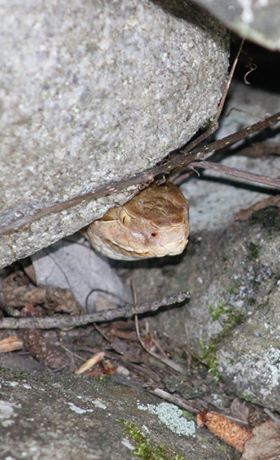
All 3 physical characteristics of pit vipers are easily seen on this copperhead (photo compliments of Randy Ratliff)
While any snake gives some folks the heebie jeebies, recognizing a non-venomous snake from a venomous one is important, should you ever become the victim of a bite.
It’s also important to learn which venomous snakes you may encounter on a hike in a specific area, how they behave in the wild, and the dangers of their venom if you are bitten. Let’s take a look at the defining features of each type of venomous snake as well as some of their behavioral tendencies.
American Copperhead
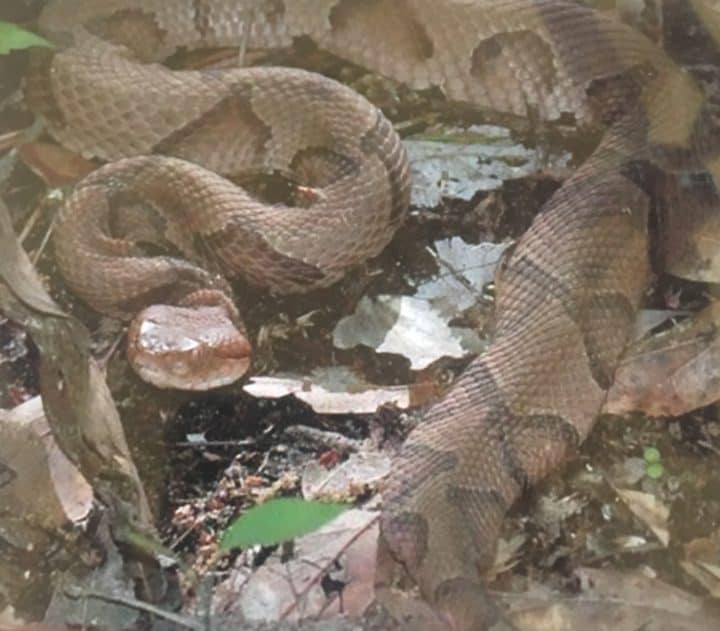
A copperhead my son found in the woods beside our house.
Copperheads are fairly recognizable by:
- Hourglass pattern on their backs
- Copper color
- Since they are a pit viper, they will also have a triangular shaped head, elliptical pupils, and the pit viper between their nostril and eye
While they are relatively easy to recognize, they are not always easy to see in the woods. Copperheads are masters at camouflage and it’s easy to completely miss seeing one as you walk by them (ask me how I know). Just Google “hard to see copperheads” and test your eyes with some of the photos that will inevitably pop up!
Of all four types of venomous snakes in the United States, copperhead venom is the least dangerous. While copperheads can still kill a person (rarely) it is not typical and most people will recover completely, especially if they seek treatment. The majority of deaths by copperheads are due to bites that were not treated.
It’s a good thing copperhead venom is the least lethal because they cause the most bites of any venomous snake each year. They don’t typically back down to a threat. And since they are so good at staying hidden, they often aren’t seen until someone is invading their “personal space.” They are quick to strike without much warning if they feel threatened.
Copperheads are found from southern New England, down the coast, throughout the entire south, and west into Texas, as well as some Midwestern states such as Illinois, Missouri, and Kansas.
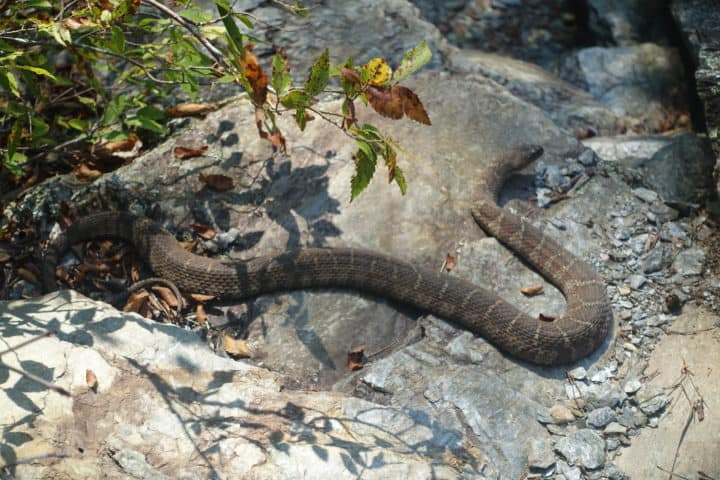
Northern Water Snakes are often confused with Copperheads and Cottonmouths (this is a beautiful water snake I encountered on a trail in the Smokies).
Cottonmouth (a.k.a Water Moccasin)
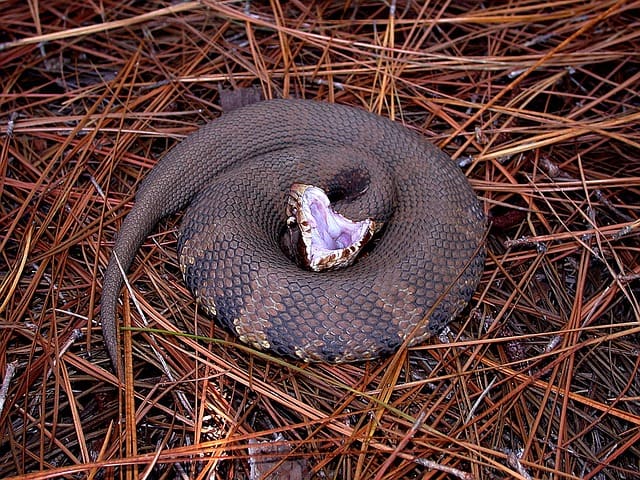
A cottonmouth’s mouth is hard to forget! (Photo compliments of Pixabay)
When I was a child, my entire posse of neighborhood friends talked about these snakes as if they were lying in wait in the creek we played in, ready to ambush every unsuspecting child who dipped their toes in the water. I suspect their nasty reputation stems from the fact that they will stand their ground if they feel threatened, often putting on a good show of hissing, beating their tail, and trying to look bigger (and these snakes can get quite big on their own, often reaching 2-4 feet in length)! The most obvious warning sign a cottonmouth snake might give, however, is opening and exposing its whitish-pinkish mouth (clearly, it’s where they get their name from), in addition to the characteristics of all pit vipers mentioned previously.
Because cottonmouth species (there are 3 of them) are semi-aquatic, they are often confused with northern water snakes which have a very similar appearance. If you see a snake in the water, cottonmouth snakes will typically swim with their head only partially submerged and their bodies on top of the water, whereas water snakes will usually swim completely submerged. This article from the Virginia Herpetological Society does a great job comparing the differences between cottonmouth and other non-venomous, lookalike snakes.
Cottonmouths are the venomous snake you are most likely to encounter during stream crossings or while taking a dip in a swimming hole or lake. If you are the unfortunate victim of a cottonmouth snake bite, as with any snake bite, seek medical attention as quickly as possible. In the United States, the last two deaths by this type of snake were both men who didn’t seek care and died a day after the bite occurred.
Cottonmouths live in the southeastern United States, from southern Virginia to Florida to eastern Texas but their distribution is scattered (see map below).
Rattlesnakes
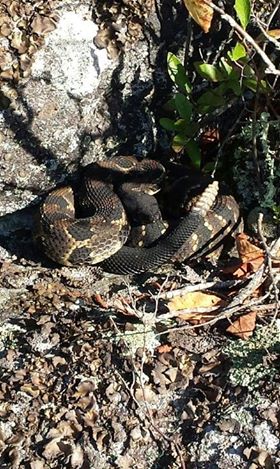
Timber Rattlesnake (photo compliments of Randy Ratliff)
There are an estimated 16-20 species of Rattlesnakes in the United States, with many more subspecies, all with their own defining physical characteristics. The good news is that they don’t all live in the same region!
Rattlesnakes are easy to recognize if you can see their tail end. And if you can’t see the rattles at the end of their body, chances are you may hear them rattling, oftentimes before you even see them (this is what has happened to me with every rattlesnake encounter I’ve ever had on trail but you can’t always rely on them giving you warning as you pass).
Some species of rattlesnakes can get enormous and their venom is no joke. Of all the pit vipers in the United States, rattlesnakes are the most dangerous in regard to the toxicity of their venom. No need to panic though, because the odds are still in your favor that you will survive envenomation from a bite, assuming you seek treatment as quickly as possible. For example, in Great Smoky Mountains National Park, where Timber Rattlesnakes love to call home, there has never been a reported death from a bite.
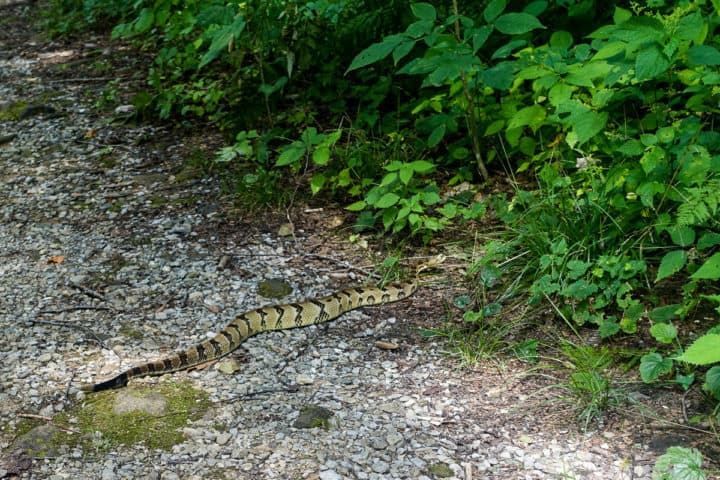
The rattlesnake I encountered on Jake’s Creek Trail in Great Smoky Mountains National Park
Rattlesnakes are generally not eager to pick a fight by a passing hiker and are only defensively aggressive if they are cornered, surprised, etc. The Eastern and Western Diamondback Rattlesnakes are the most dangerous of the bunch and account for the majority of deaths in the United States. The silver lining is that they only account for 10% of the venomous snake bites in the country.
Here’s a short video clip I took of a Timber Rattlesnake I encountered on the Lynn Camp Prong Trail in Great Smoky Mountains National park. He was right beside the trail as I walked by and rattled incessantly to warn me of his presence. It’s good to recognize the way a rattlesnake sounds, so you’ll know if you hear the sound on a hike.
Coral Snakes
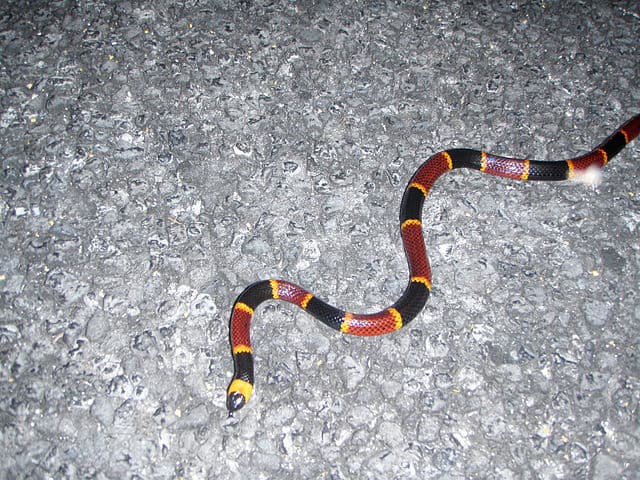
Coral snake (photo compliments of Wikicommons)
Since coral snakes are in the cobra family, they do not have the same defining features of a pit viper. Their pupils are round, their head is not triangular shaped, and they do not have a heat-sensing pit.
But that doesn’t make them any less venomous. In fact, coral snake venom is potent and the most deadly of all the snakes in the United States; however, these snakes are extremely shy and the vast majority of people who suffer from their bite are provoking the snake.
If it makes you feel any better, no one in the United States has died from a coral snake bite since 1967 (and this snake was being provoked and the owner did not seek treatment after the bite). There are only 15-25 recorded coral snake bites each year, according to American National Institutes of Health.
There’s a great rhyme you can remember for identifying coral snakes versus non-venomous snakes that look similar, like a king snake: “Red on yellow, kill a fellow. Red on black, safe on Jack.” This simply means if you see a red band touching a yellow band on a snake’s body, you’re looking at a coral snake. If red touches black, it’s non venomous (but don’t forget, non venomous snakes can still bite and can still cause pain, infection, etc).
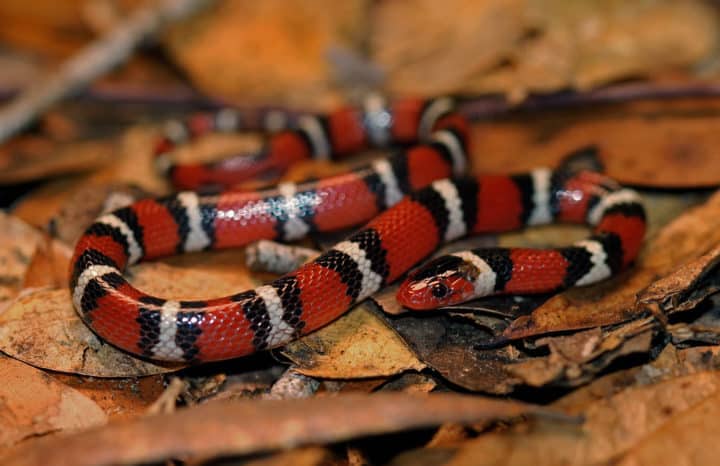
This Scarlet King Snake has a red band touching a black band, indicating it is nonvenomous.
How Dangerous are Venomous Snakes?
Let’s just get this out there first, no one likes to think of suffering from a nasty bite from a snake while in the backcountry, but many hikers are far more fearful of the chance of it happening than they should be. Not to mention the fear of dying from the bite. While it does happen, it’s far less common than you think to die of a snake bite or be bitten by one, with practical precautionary measures.
Very few people die from snake bites. It is estimated that between 7000-8000 people are bitten by venomous snakes in the United States but only 5-6 die from them. Statistically speaking, only one in 500 people dies from being bitten by a snake.
To put it another way, and to hopefully give you a bit more reassurance (unless you’re caught on a mountaintop during a thunderstorm), you are 9 times more likely to die from a lightning strike than you are dying from a snake bite!
Even if you are bitten by a venomous snake, there is a 25-40% chance it was a “dry bite,” meaning the snake did not release any venom into your body (pit vipers lean on the side of 25% dry bites whereas coral snakes are upwards of 40%).
Since snakes use their venom on prey, they like to reserve it for mealtime (and no, they’re not looking at you as a food source). When a snake bites a human or dog, it’s usually acting defensively.
Interestingly, older snakes tend to have more control over their venom, while younger snakes are likely to dump all of it in a defensive bite; however, older snakes have more venom to inject, if they decide to use it on you. There is a bit of controversy over young versus old snakes controlling their venom more, so it’s clearly important to be safe around any venomous snake (or any snake, for that matter, if you’re unsure if it’s venomous or not).
How Can I Prevent A Snake Bite While Hiking?
As with many things, common sense goes a long way when preventing a snake from biting you. There are, however, some general guidelines I encourage and practice, to prevent anything more than a friendly encounter with a snake in the backcountry.
- Before hiking in an area, educate yourself about the venomous snakes of that area, so you’ll know what they look like and how they behave.
- Watch for snakes on or beside the trail, especially in sunny and/or rocky areas where they may be basking.
- Stay on the trail. Most snakes I encounter on hikes aren’t directly on the trail but off of it, sunning themselves on rocks, nestled in the brush beside the trail, etc.
- Listen for rattlesnakes (if you like to hike with earbuds sometimes, only use one, and keep the volume very low).
- When traveling through grassy areas or where the trail is obscured, use a hiking pole to “sweep” the path ahead.
- Step on logs across the trails, not directly over them, so you can see where your foot will land.
- If you see a snake, keep a safe distance and give it a wide berth.
- Do not try to “chase” a snake off a trail or kill it. This is a common way people get bitten.
- Make sure there aren’t any other snakes nearby if you see one along the trail.
- Look carefully before you sit, squat to use the bathroom, etc.
- If night hiking, take extra precautions with scanning the trail ahead with a light source as snakes are very active at night.
- This should go without saying, but don’t be “that guy” who harasses and taunts a snake. You’re just tempting fate (and karma).
- Keep your dogs on leash at all times during a hike.
- In some areas of the country, such as the desert southwest, rattlesnake training is available for dogs through various trainers.
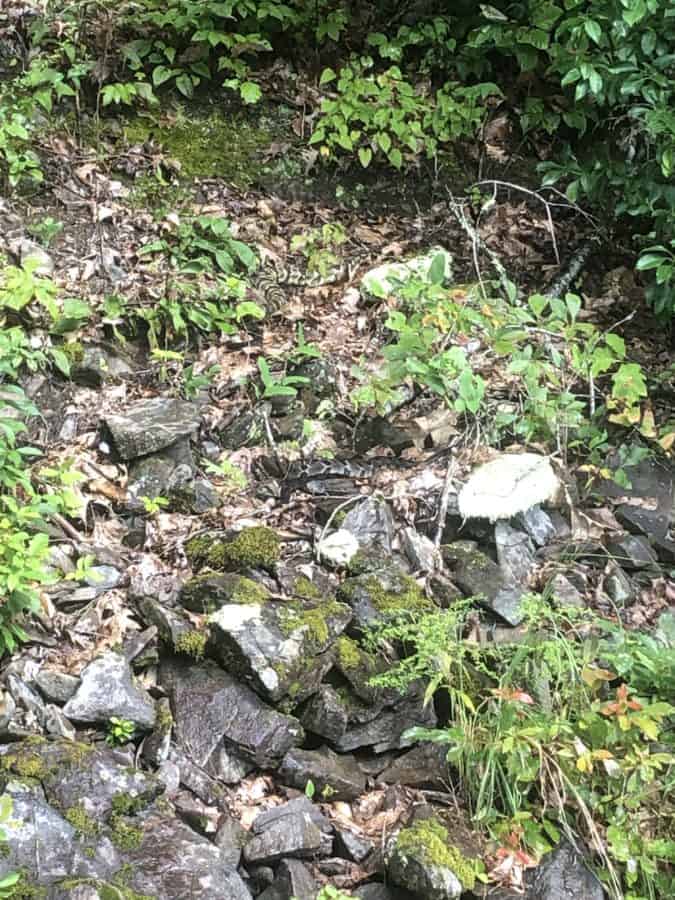
How many snakes can you find in this photograph. Hint: There are 2 species, both venomous, and this was taken in Great Smoky Mtns. National Park. The answer is at the bottom of this post with a key showing where they are in the photo.
What are the symptoms of a snake bite?
Symptoms of snake bites vary, depending on several factors:
- What type of snake bites you (there are differences in both venomous vs. nonvenomous snake bites as well as individual differences in all the specific species of snakes).
- If a venomous snake’s bite was “wet” or “dry” (in other words, if it injected venom into you or not)
- There is also individual variation with symptoms, depending on your own body’s reaction
Since most folks are worried about venomous snakes and the harm of their bites, we’ll focus the discussion on those species. Far and away, the most common sign of a “wet bite” from a venomous snake is a rapid onset of both pain and swelling at the bite site.
Aside from rapid pain and swelling, the following are a list of symptoms common to “wet” venomous snake bites:
- Pair of puncture wounds (sometimes only one fang will penetrate though)
- Metallic taste in mouth
- Change to sense of smell
- Visual abnormalities (double vision, loss of vision)
- Ringing in ears
- Headache
- Nausea and vomiting
- Dizziness
- Shortness of Breath
As with any foreign enzyme or protein injected into a human or animal, anaphylactic reactions can also occur after venomous snake bites. By definition, an anaphylactic reaction is when two organ systems are reacting negatively to the introduction of a foreign substance. For example, if someone is having difficulty breathing while simultaneously feeling nauseated, it likely means they are experiencing an anaphylactic reaction to a snake bite.
What should you do if you’re bitten by a snake?
- Remember the STOP acronym (Stop, Think, Observe, and Plan). Taking a few minutes to calm yourself down and come up with a logical plan is paramount after a snake bite.
- Make a mental note of what the snake looks like (color, markings, etc). and/or take a photo from a safe distance. Do not, however, risk getting bit again by taking a photo or looking at the snake!
- Take a photo of the bite site (esp. on your pet) and/or draw a circle around it if you have a writing utensil in your pack (oftentimes, as skin swells at the area of a snake bite, it can become more difficult to see where the snake’s fangs penetrated the skin).
- Make note of the time the bite occurred.
- Remove any jewelry. Since bites often cause swelling (and sometimes quickly and profoundly, you don’t want to wait to try and get your wedding band, or other jewelry off, once it starts).
- A light bandage is ok if there is excessive bleeding but otherwise there is no need for a bandage (this rule is slightly different if you are bitten by a coral snake, in which case a compression bandage may be beneficial).
- If bitten on a limb, splint it to restrict movement, if possible. Also, if you know a rattlesnake bit you, it’s advisable to keep the affected body part at heart level, if possible. For copperhead and cottonmouth bites, it’s advisable to keep the affected body part above heart level, if possible.
- Since anaphylaxis is possible after a snake bite, an EpiPen may be beneficial, if you suspect anaphylaxis is occurring.
Beyond these basic suggestions, some subjectivity also comes into play after someone is bitten, depending if you are hiking solo or with others, if you have a satellite device to call for help, and how poorly the victim feels and how capable he/she is of walking out of the woods to seek help.
If you are hiking solo and do not carry a satellite or PLB device, your only choice is to walk out of the woods, hike to the trailhead deliberately but slowly enough to keep your heart rate from skyrocketing and spreading venom more quickly. Once out of the woods, drive yourself to a hospital immediately. If you aren’t feeling well enough to drive but have cell service, call 911.
If you are hiking with someone else, see if they can walk out on their own.
Take the time to assess the surrounding trail system before hiking out. Even if your car is at one trailhead, study your map for the closest trailhead that has a high likelihood of having people at it (we all know those trailheads that are jam packed, no matter what the time of year). If that trailhead is significantly closer than where your car is, I’d personally take that route instead.
If you carry a satellite device or PLB (or someone you’re hiking with has one), use your best judgement for the situation. If you feel it’s possible to walk out, you will likely get to a hospital quicker. Search and rescue teams take time to mobilize and enter the woods, even if you’re close to a trailhead. There’s a good chance you can walk out, even at a slower pace, and come out ahead from a time perspective versus waiting on a SAR team to carry you out.
And finally, if you have a satellite device with messaging capabilities (like a Garmin InReach Mini, my personal favorite), and you think you can walk out on your own, message someone who can meet you at the trailhead, so they can drive you to seek care. If envenomated, you have no way of knowing what kind of shape you’ll be in when you get out of the woods and if you’ll be capable of driving yourself to a hospital. It’s best to have help ready and waiting for you. It’s also wise to share your location when you first message someone, so they’ll know where to direct a SAR team, if you don’t show up at the trailhead.
What do I do if my dog is bitten by a venomous snake on a hike?
The biggest takeaway is to get him/her out of the woods and to your veterinarian or an emergency hospital ASAP. Your car keys are the best form of treatment in the backcountry for your dog. There are now rescue harnesses on the market to carry dogs out on your back, and these may be wise to carry if your dog is larger and difficult to carry.
If your pet is bitten and it’s not too difficult, give your dog Benadryl/diphenhydramine at a dose of 1 mg per pound of body weight. With snake bites, Benadryl/diphenhydramine doesn’t help with swelling, unfortunately, so you shouldn’t be surprised if the affected body part swells (sometimes significantly and rapidly). There is controversy in the veterinary community about giving Benadryl at all for snake bites, however, if your dog ends up having anti venom administered at your veterinarian’s office, I believe it can be helpful to already have it in a dog’s system to help prevent an anaphylactic reaction from the serum.
Even if you saw the snake that bit your dog and know it is a nonvenomous species, I still recommend having your dog seen by your veterinarian ASAP. Just because a nonvenomous snake bites you or your dog, doesn’t mean you can’t have issues, like infection, from it (I’m a small animal veterinarian, by the way).
What NOT to do if you’re bitten by a snake on a hike
Equally as important as the steps you should take after a a snake bite are the steps you shouldn’t take:
- Do NOT try to suck the venom out (you run the risk of contaminating the bite with bacteria from your own mouth, and it’s completely ineffective anyway).
- Do NOT try to open the site more with a knife (you risk damaging the surrounding tissue and it’s not going to do you a darn bit of good to open up the site anyway)
- Do NOT use snake bite kits (truly, they are useless)
- Do NOT try to capture or kill the snake (taking a photo to show the doctor, from a safe distance, is fine; however, don’t risk another bite from an already agitated snake by trying to capture or kill it!).
- Do NOT apply a tourniquet above the bite site (you can actually do more harm than good with a tourniquet, since you’re cutting off your circulation for an extended period and also concentrating the venom into one spot which can make things worse).
- Do NOT apply a cold pack or ice to the bite site (this sounds counterintuitive in some ways, but current medical advise is to steer clear of cold or heat compresses at the site, at least for more than a few minutes).
- Do NOT wait to see if you have symptoms from a venomous snake bite before going to the doctor. Be seen by a doctor as soon as possible if you know a venomous snake bit you. Many deaths from venomous snake bites occur when victims choose to wait it out, and the venom causes cumulative problems that possibly could have been mitigated with more urgent medical care.
This is a great article from Spencer Greene, MD, a medical toxicologist and emergency physician at Baylor College of Medicine in Houston, Texas, about pre-hospital management of snake bites. Dr. Greene has treated 600+ snakebites and directs one of the busiest snakebite services in the U.S. In other words, he knows his stuff (and has a wealth of information on this site about snakes in general).
In conclusion, I urge you to get out and enjoy the natural world and not let your fear of snakes (or spiders, or bears, or whatever scares you the most in the backcountry) stop you in your tracks. In all my years and miles of hiking, I’ve never had a bad encounter with a venomous snake, and I’ve come across plenty of them.
I also know someone who hikes extensively in Great Smoky Mountains National Park and finds venomous snakes frequently. He has never once been bitten and stresses that they are shy, in general, unless provoked. The key to avoiding a nasty encounter is to arm yourself with knowledge. And guess what? You just did that by reading this post, so high five and happy trails!
Happy trails,
Nancy
P.S. If you found this content valuable, consider signing up for a short series of emails outlining what search and rescue (SAR) teams wished every hiker knew before entering the woods. My primary objective with this blog is to work myself out of my job on my county’s SAR team! 🙂
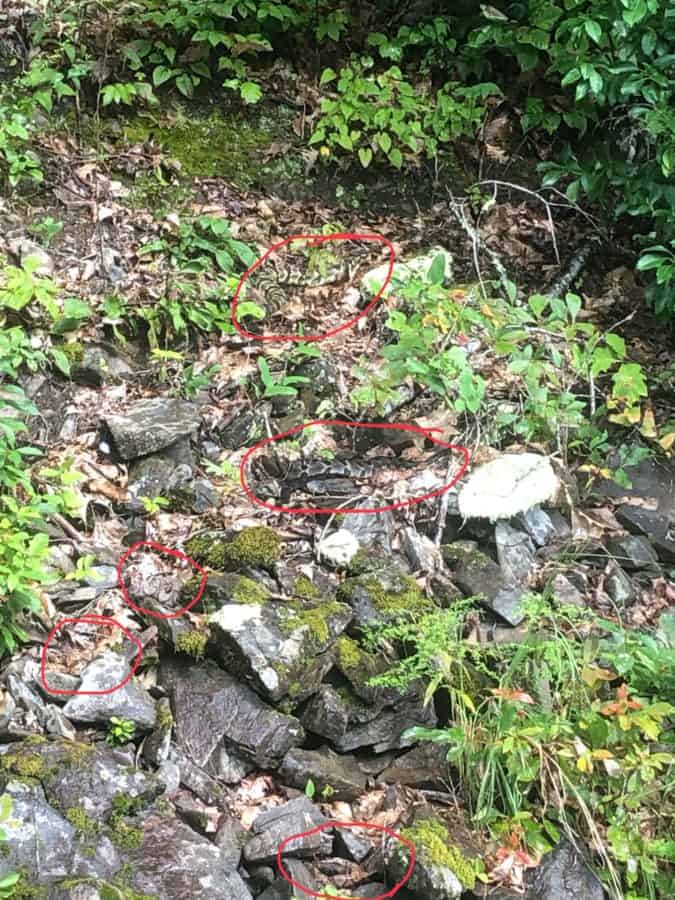
The answer to the snake quiz earlier in the post is 5 (at least that I can tell!). There are 2 Timber Rattlesnakes and 3 Northern Copperheads. The second circle from the top has one of each species represented. These 2 photos are compliments of my friend and fellow SAR team member, Kyle James.
References:
Savannah River Ecology Laboratory
Virginia Herpetological Society
Center for North American Herpetology
Wild Snakes: Education and Discussion
As a side note, I invite you to join my Facebook group, if you’d like to learn more about preparedness and outdoor education topics (as well as find some great deals on gear that I post from various retailers). I host regular “Facebook Live” events on various safety topics and the group is incredibly friendly and supportive to newbie hikers.
[content-upgrade id=”3141″]
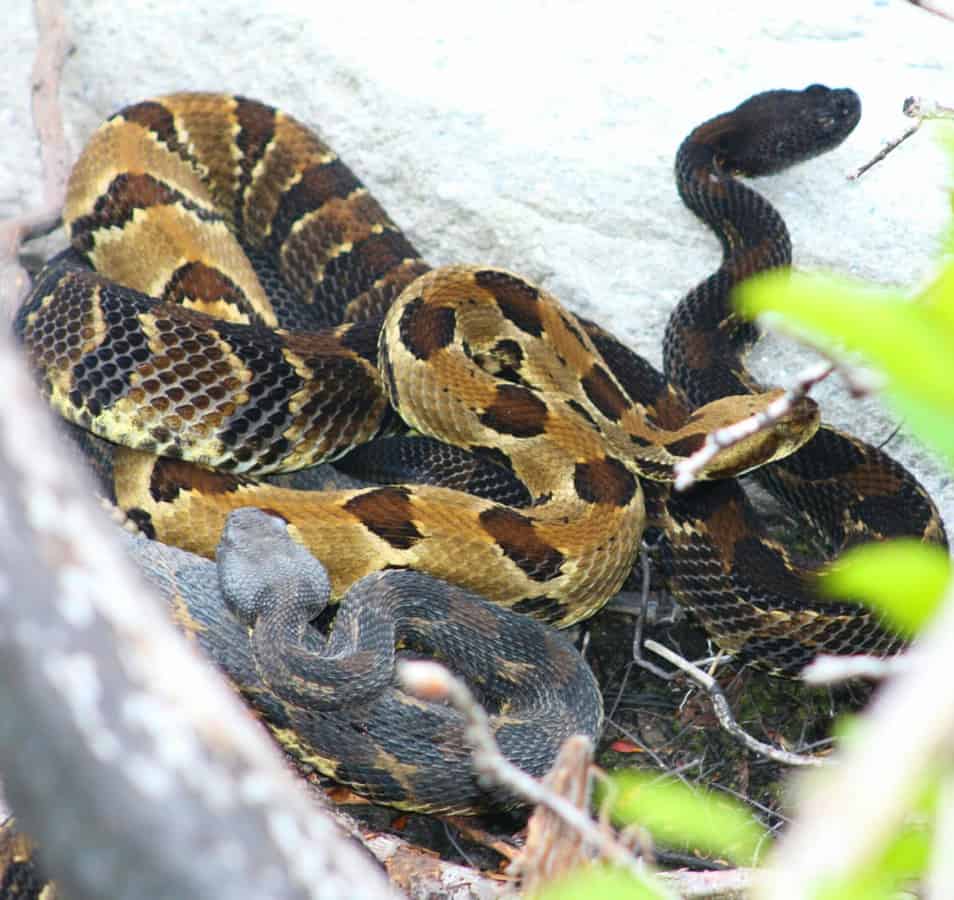
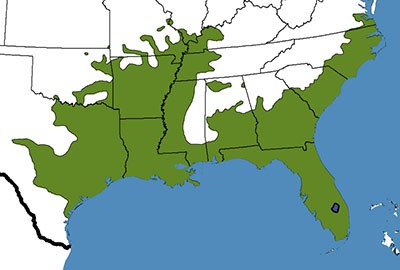
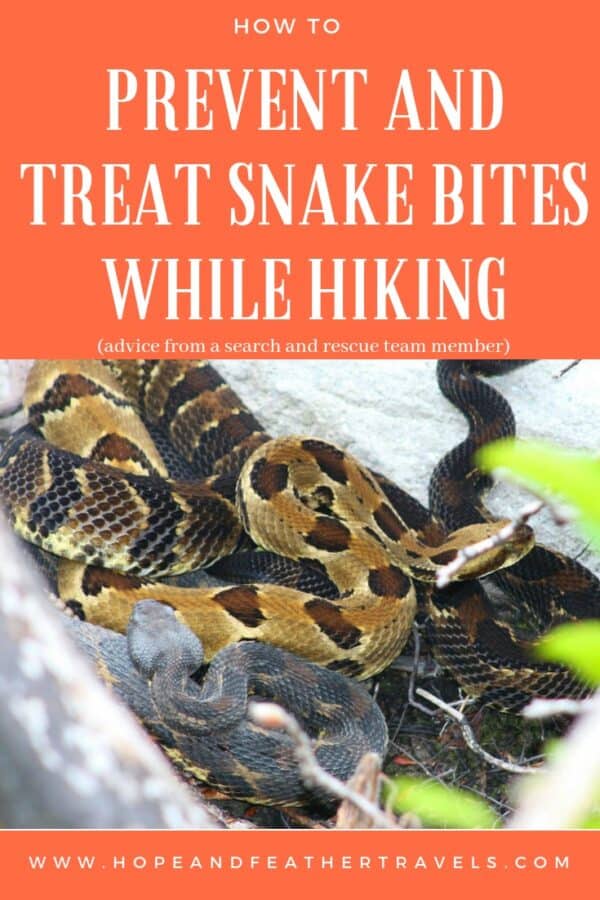
Great article, full of accurate information! Thank you for sharing our article from Dr. Greene.
Thank you so much for chiming in, Bridgette! I absolutely love your site and it is incredibly helpful to me as I educate myself more and more about snakes. For those of you reading this and are curious what the site is, it’s https://wsed.org/ (Wild Snakes: Education and Discussion). 🙂